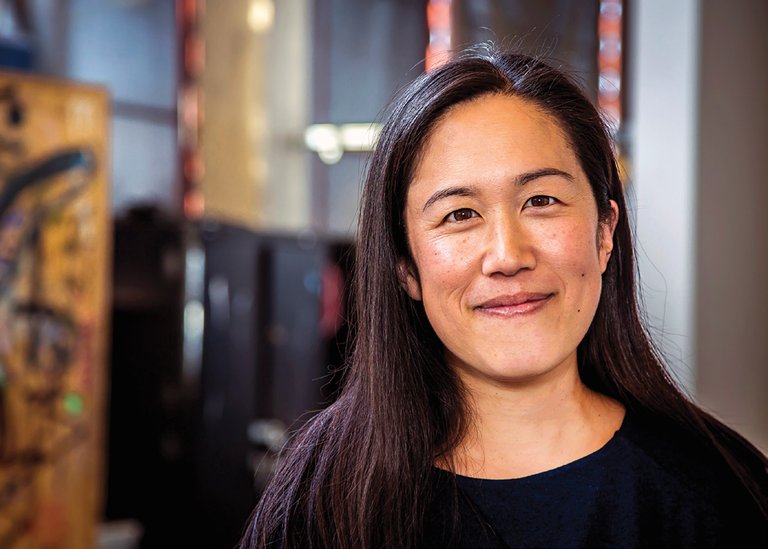
Faculty spotlight: Irene Cheng, Assistant Professor, Architecture Program
Faculty Spotlight is an editorial series that showcases CCA's wide range of faculty members.
Architecture and Interior Design assistant professor Irene Cheng’s workday doesn’t end when she leaves campus. For starters, she’s a historian, critic, author, and designer. A founder of the multidisciplinary design firm Cheng+Snyder, Cheng’s work has been featured internationally in Metropolis, Architectural Record, the New York Times, and the 2012 Venice Biennale. Even her own home was recently the subject of a Dwell feature. Alongside David Gissen, Cheng also co-directs the History Theory Experiments—a platform that explores experimental work in architectural history. Despite her many hats, Cheng radiates passion for each and every one of her projects.
How did you first realize that you wanted to work in architecture?
I took a few classes in architecture as an undergraduate, but I was also drawn to a career in public interest law. When I graduated from college I applied to law schools. As a reward to myself for finishing my applications, I purchased an architecture book (Rem Koolhaas’s landmark book SMLXL, which had just come out). I realized this was a little paradoxical, and it made me see where my true passions lie!
What drew you to teaching and why do you continue to do so?
I had many wonderful teachers, from grade school through graduate school, who were more than just instructors: They profoundly shaped how I see the world and my role in it. My hope is to have the same impact on my students.
In my architectural history and theory classes, I emphasize how architecture is related to the economy, art, politics, and philosophy, and the environment. It’s my hope that students, after taking my courses, won’t be able to see a building in the same way again, that they’ll regard each work of architecture as a moment to ask larger questions about the world around them.
I’m interested in cultivating students’ capacities in critical thinking, design, reading, and writing, in order to make them not just better scholars or designers, but also ethical, active agents in the world.
Lastly, teaching is a two-way street. I love the energy and knowledge that I get from my students: They challenge and teach me new things every day.
What does CCA offer that sets it apart from other schools?
What I love most about CCA is its spirit of experimentation and its commitment to combining art and design with political engagement. I love walking into the Nave and seeing all the experiments being done by students outside my division—fashion and furniture designs, paintings, strange little videos, and mysterious installations. Architecture can be a very rigid discipline. Working among artists reminds me that the rules aren’t written in stone. I feel hugely inspired by the atmosphere of playful experimentation and provocation at the school.
I also value the college’s general commitment to equity and social justice. CCA is probably the most progressive institution of higher ed that I’ve been at.
When you’re not at CCA, what are you doing (professionally and/or recreationally)?
I am finishing writing a book on the history of 19th-century utopian architecture and city plans in the United States. A few years ago I co-founded the Race and Modern Architecture Project—an international, interdisciplinary research group that is exploring how ideas about race shaped modern architecture practice and theory. We organized a big conference on the topic last year and will put out an edited book next year. Those are the two big projects I’m working on at the moment.
When I’m not teaching, researching, and writing, I am usually spending time with my family. I have two kids, ages 5 and 7. I like to travel, cook, and read. I have recently become mildly obsessed with gardening.
What’s the best piece of advice you’ve ever received, and what advice do you have for students?
My father once told me that you can start to like anything if you go deep enough into it. He was basically saying to avoid dilettantism and commit to cultivating an expertise in one area. That’s stuck with me—the idea of deriving pleasure and satisfaction from working hard and developing virtuosity in one skill or discipline.
One thing I try to emphasize to my students is to work smarter rather than harder. There’s a long tradition in architecture school of working long, grueling hours and staying up all night to finish a project, especially during the last days before reviews. I often tell students that my most successful semester in architecture school was one where I went to see a movie every night in the week before my final review. I was working 14-hour days, but I also took a couple hours each day to reconnect with the outside world, get inspired, and gain perspective.
You will always make better work and decisions when you are happy and have slept.